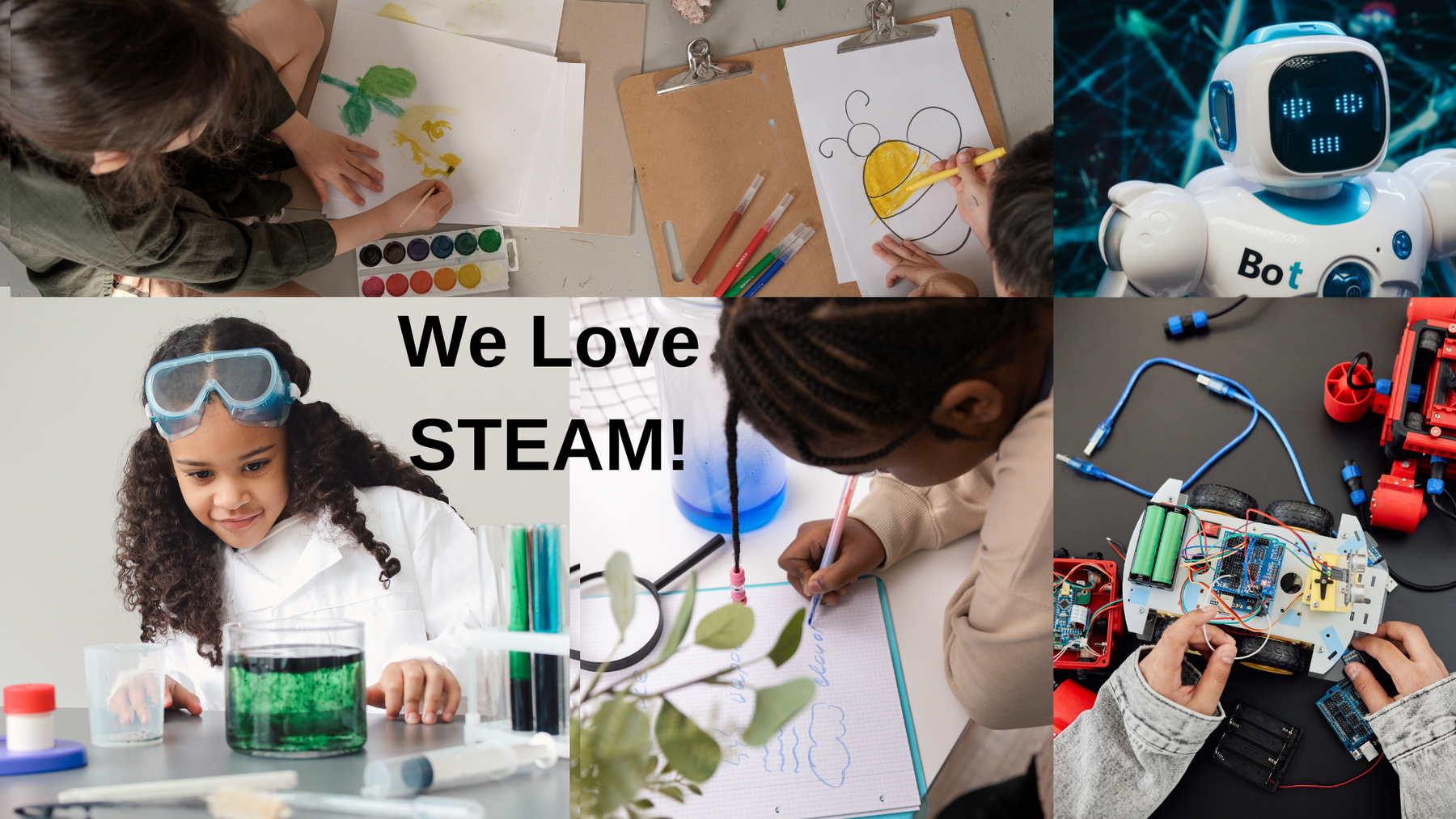
STEAM - What It Is and Why We Love It!
What is STEAM?
It stands for Science, Technology, Engineering, Arts, and Mathematics. This collection of disciplines represents key areas of education. While the focus originally was on those subjects that are thought of as more practical (“hard science”), the addition of “Arts” to the list acknowledges the important role Arts can play in the fields of science and technology–and in life in general. For example, innovative engineering requires a good dose of creative thinking and unique design.
STEAM is not just for kids who want to grow up to be scientists and engineers. As technology all around us continues to develop in new and interesting ways, learning about the concepts of how all things work can help people understand the world they live in, and be better informed about the tech they encounter and use throughout their lives. Learning natural branches of science like chemistry and biology will create a greater understanding of our relationship with the planet. Among many benefits, the Arts cultivate creativity and self-confidence, which can help anyone succeed in all aspects of life, both professional and personal.
STEAM toys, games, kits, books, etc. approach education with fun and stimulating activities, objects, and visuals to help spark interest and engagement with each topic under the STEAM umbrella (for beginners) or to give kids with those specific interests more opportunities to learn and create (for kids already on the STEAM train).
Why do we love STEAM?
1. Great educational value.
One thing all good STEAM toys have is educational value. STEAM products can provide a fun and exciting introduction to important basic concepts and how things work, giving kids who use them a better understanding of the world around them. They can be used to enhance and develop the understanding of what they’re learning in school, or to explore their interests beyond their current classroom curricula. Learning based on memorizing information and tests is rarely effective for deeper, long-term knowledge. Hands-on activities, games, and tools are much more beneficial for education – they are engaging and fun, which can help kids to pay better attention and retain more of what they learn.
DIY exploding volcanoes, creating geometric fractal designs, building a DIY remote control vehicle with LED elements, making your own slime, chemistry sets that let you explore all kinds of reactions (safely) – just a few examples of STEAM activities that people love to do, depending on their specific interests. There may be toys you didn’t even realize fell into the category of STEAM, like Lego (construction, design, engineering) and paper airplanes (physics, aerodynamics).
5. Options abound with a variety of great products!
Another awesome thing about STEAM toys is the wide variety of options out there under each different letter, sometimes even combining a few branches in one toy or product. You’ll find toys and kits featuring robotics, construction, visual art, math, chemistry, physics, and more! If a child is not that into one area of STEAM, they might have a great interest in another. As they delve into STEAM projects, they may begin to understand and appreciate one branch they aren’t that into as it connects to some of the others.
There are always new toys coming out, and therefore new STEAM options all the time. The Toy Association has a program for brands and creators to get STEAM Accreditation for products – while it’s not the only way to find good STEAM toys, it’s a good sign if they have that stamp of approval! (You can get more details on that by going to link 1 at the bottom of this post.) Some of our brands of choice for quality, fun, and value are Thames & Kosmos, Copernicus, Magna-Tiles, and Mindware.
We also found this helpful guide on what makes a good STEAM toy: Good STEAM Toy Characteristics. It lays out different functions and aspects of products and how to recognize superior items. For example, a toy might be fun and enjoyable, but not do much to develop skills and knowledge, or maybe it effectively teaches skills and is easy for the target age range to use but doesn’t hold interest. The best toys, according to this assessment, are fun to use, easy to work with for the target age without assistance, actively help develop important skills, and are inclusive for different genders and physical abilities. While we don’t see anything wrong with needing the help of a parent, it can be discouraging for a child if they can’t figure out the toy on their own. Note: a toy being “fun and engaging” is the first item on the chart, because a toy can’t teach anything if a kid is not interested in using it!
As you can see, there are a lot of great reasons to love STEAM. It combines fun and education in a way that can be very beneficial for kids. With the variety of subjects under the STEAM umbrella and the constant development of exciting new products, there are great toys or kits available for just about every interest and age.
Sources and Background
- https://www.toyassociation.org/ta/research/reports/stem-steam/toys/research-and-data/reports/stem-steam.aspx?hkey=6e80262f-1fea-4b37-a5e2-9679ec26f048
- https://thegeniusofplay.org/App_Themes/tgop/pdfs/steam/prime-steam-attributes.pdf
- https://thegeniusofplay.org/App_Themes/tgop/pdfs/steam/good-toy-characteristics.pdf
- https://thegeniusofplay.org/tgop/toy/genius/time/decoding-steam.aspx

